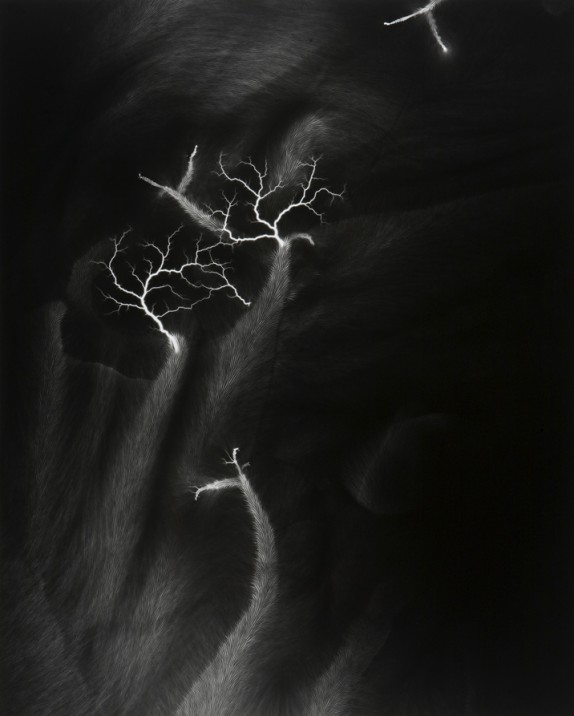"The land between Klarälven River and the chestnut tree at Ekallén is full of little hard memories of sad and lonely times, but there is also a streak of warm confidence that runs all the way up to Älgsjövallen, a place of fairy tales and inquisitive moose." Anders Petersen
From Back Home is a collaboration between two of Sweden's leading photographers, Anders Petersen (b. 1944) and JH Engström (b. 1969), focusing on the Värmland region, one of the most sparsely populated provinces in Sweden. The two photographers have a shared relationship with the land—they both come from this region—as well as a strong personal relationship. Engström worked as Petersen's assistant and the older man is a major influence for him.
The book
 From Back Home won the Author Book Award at Arles 2009 and deservedly so. The book is split into two parts, first Petersen's images followed by Engström's. Petersen's section starts with the birth of a child suggesting that this will be a journey of intense discovery. The first few images immediately set a mystical, slightly oppressive, dark and lonely tone.
From Back Home won the Author Book Award at Arles 2009 and deservedly so. The book is split into two parts, first Petersen's images followed by Engström's. Petersen's section starts with the birth of a child suggesting that this will be a journey of intense discovery. The first few images immediately set a mystical, slightly oppressive, dark and lonely tone.
I find that Petersen's vision has become more concentrated and more potent with time. His signature high-contrast black-and-white imagery crackles with energy as we are taken from birth to death and everything in between (although love seems to have the last word). Petersen's series centres mainly on the people that cross his path, photographs of random encounters mix with those of friends, family and lovers. The series is also punctuated with little details of the surrounding landscape (an empty skatepark surrounded by forest, a tree snapped in half). Petersen has said before that he is seeking to become almost animal-like in his approach, to become a dog when he photographs, and this also comes through clearly in his raw, angular images. Animals also appear intermittently as subjects, reminding us of our mortality and of the fact that we are just another creature that will come and go.
The cover image (above), a photograph by Petersen of his mother, is one of the most haunting portraits I have come across in some time. It is full of dignity, an almost classical image, but there is a certain distance between the photographer and his subject which seems to contain all of the complexity of Petersen's relationship with 'home'.
The second half of the book is devoted to Engström's work. As opposed to Petersen, Engström hasn't adopted and honed a signature style, instead mixing lo-fi, washed out colour images, with cheap flash portraits or high-contrast black and white landscapes. He focuses mainly on life at night, from the drunken fumblings of teenagers in the forest to old couples pressed together at a dance. His photographs seem instinctive (in his introduction he writes "I've returned to something that my body and emotions recognize"), and he succeeds in creating a sense of openness and immediacy. There are also a number of photographs of collages of several polaroids or small prints: a device that seems to be a way for Engström to revisit his memories, heightening the sense of return rather than of discovery.
Unfortunately, I found that his work suffered a little when juxtaposed with Petersen's. The power and refinement of the older photographer's images slightly overpower Engström's looser and more diffuse approach. I also found some of the juxtapositions of images bizarre, with a result that seemed to add up to less than the sum of its parts.
Despite this minor reservation, this is a very successful book and the relationships between these two photographers and this remote region is undeniably powerful and complex. The printing of the book is beautiful and I found that the black-and-white work was particularly well reproduced.
From Back Home (Stockholm: Bokförlaget Max Ström, 320 pages, hardcover, 2009).
Rating: Highly recommended
The exhibition
The From Back Home project has also led to an exhibition, which is currently on show at Galerie VU in Paris. In addition to the prints from the From Back Home series, the exhibition also includes an additional series of vintage works by both photographers.
For Petersen's From Back Home work, it was interesting to see the prints hung in a floor-to-ceiling grid three prints high. The prints are not quite as good as the reproductions in the book and many of them were buckling slightly as they did not seem to have been dry-mounted (I heard Petersen pointing this out to the gallery so this may end up getting fixed), but the full wall of images works well for this work. The vintage work that is shown alongside these is Gröna Lund, a series of images taken at an amusement park in Sweden in the late 1960s and early 1970s. I found it fascinating to see the evolution in Petersen's approach. His photographs have gained a heightened intensity and visceral energy, making his earlier work seem almost restrained. His latest work feels a lot closer to Moriyama's sensibility, darker and more animalistic.
In Engström's case the second series of work on show are unseen 'vintage' (it always strikes me as strange to call something that is only a few years old 'vintage') prints from his Trying to Dance series. Although I'm not sure that the 'vintageness' is so important to his work, this is one of his strongest series in my view and an interesting precursor to From Back Home. Overall I found that this latter work came through better in the exhibition than in the book. The intentionally haphazard framing and hanging of his prints worked well for me and gave the impression of being invited into Engström's living room. I was particularly struck by a group of six highly grainy and contrasty aerial photographs of the Värmland landscape which are hung separately to the rest of the prints, a step back from those moments of intimacy that lends a darker edge to the series.
I would recommend the book over the exhibition, as I think From Back Home is probably better-suited to the book format, but the show is definitely worth a visit.
From Back Home. Anders Petersen and JH Engström. Galerie VU, 11 September - 31 October 2009.
Rating: Recommended
Update: This review has also been published on Lensculture along with a few other photobook reviews that I have been contributing to Jim's excellent webzine.




